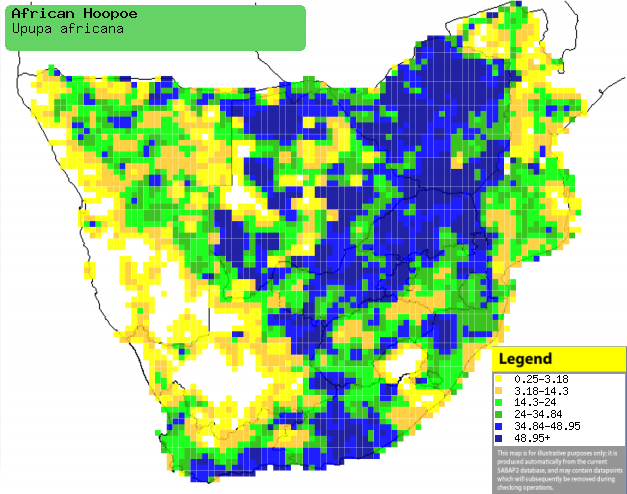|
Upupa africana (African
hoopoe)
[= Upupa epops]
Hoephoep [Afrikaans]; Ubhobhoyi [Xhosa]; umZolozolo, uZiningweni
[Zulu]; Kangungu/Nduranganga [Kwangali]; Popopo, Khapopo, Pupupu, 'Mamokete
[South Sotho]; Kukuku [North Sotho]; Mhupupu [Shona]; Umphuphuphu [Swazi];
Pupupu [Tsonga]; MmadilÍpÍ, Pupupu [Tswana]; Hop [Dutch]; Huppe d'Afrique
[French]; Wiedehopf [German]; Poupa [Portuguese]
Life
> Eukaryotes >
Opisthokonta
> Metazoa (animals) >
Bilateria >
Deuterostomia > Chordata >
Craniata > Vertebrata (vertebrates) > Gnathostomata (jawed
vertebrates) > Teleostomi (teleost fish) > Osteichthyes (bony fish) > Class:
Sarcopterygii (lobe-finned
fish) > Stegocephalia (terrestrial
vertebrates) > Tetrapoda
(four-legged vertebrates) > Reptiliomorpha > Amniota >
Reptilia (reptiles) >
Romeriida > Diapsida > Archosauromorpha > Archosauria >
Dinosauria
(dinosaurs) > Saurischia > Theropoda (bipedal predatory dinosaurs) >
Coelurosauria > Maniraptora > Aves
(birds) > Order: Upupiformes > Family: Upupidae
The African hoopoe is a very widespread range, found
everywhere in southern Africa except deserts, karoo and, strangely, Lesotho. It
mainly lives in tall woodlands with short cut grass undergrowth, but it has also
adapted well to living with humans, and can be found in many urban areas. It
feeds on insects, probing the ground with its bill. It often nests in tree holes
up to 8m above ground, as well as a number of man-made structures. It lays 4-7
eggs, which are incubated exclusively by the female. The chicks stay in the nest
for 26-32 days before leaving the nest for the surrounding foliage. They remain
dependent on their parents for at least 1 month before becoming fully
independent.
For information about this species, see
www.birdforum.net/opus/Upupa_africana
Distribution and habitat
It occurs almost everywhere in southern Africa
except for deserts, arid karoo and Lesotho. It generally prefers
open woodland with short grass undergrowth, and it has adapted well to the
introduction of man-made habitats, such as parks, gardens, orchards and
plantations.
|
 |
|
Distribution of African hoopoe in southern Africa,
based on statistical smoothing of the records from first SA Bird Atlas
Project (©
Animal Demography unit, University of
Cape Town; smoothing by Birgit Erni and Francesca Little). Colours range
from dark blue (most common) through to yellow (least common).
See here for the latest distribution
from the SABAP2. |
Brood parasites
It has been recorded as host of the
Greater honeyguide.
Food
Feeds throughout the day, usually in low
grass or bare soil. It probes the ground with its slightly open bill, trying
to find insects. Once the prey is caught, it will sometimes beat the prey on the
ground in order to reduce it to bite-size pieces. The following prey items have been
recorded in its diet:
Breeding
- It mainly nests in tree holes, either natural or made by barbets or
woodpeckers. It can also
nest in a termite mound, stone wall, ground hole, drainage pipe, crevice in
masonry, underfloor space, house ceiling or nest box. The nest is
always chosen by the male, who defends it vigorously.
- Egg-laying season is from August-February, peaking at September-November.
- It lays 4-7 eggs, usually in successive days, although it sometimes
takes a two day break between the first and second egg.
- Incubation starts when the last egg has been laid, and is done solely by
the female for 15-16 days. The female will huff and hiss if disturbed on
nest.
- The male does all the hunting for the chicks in the first 7-8 days of
their lives, after which the female joins
in as well. The following prey item have been recorded in the chicks diet:
- Invertebrates
- insects
- grubs
- worms
- slugs
- Vertebrates
- The chicks stay in the nest for 26-32 days, after which they leave the
nest for the surrounding foliage, becoming fully independent about a month
later.
Threats
Not threatened, although out competed for nesting sites in
urban areas by Common starling.
References
-
Hockey PAR, Dean WRJ and Ryan PG (eds) 2005. Roberts
- Birds of southern Africa, VIIth ed. The Trustees of the John Voelcker
Bird Book Fund, Cape Town.
|
